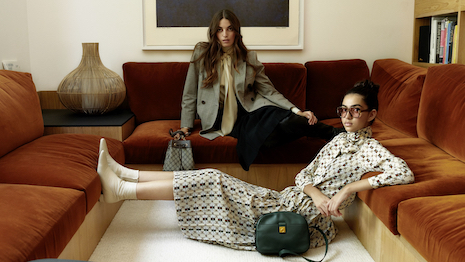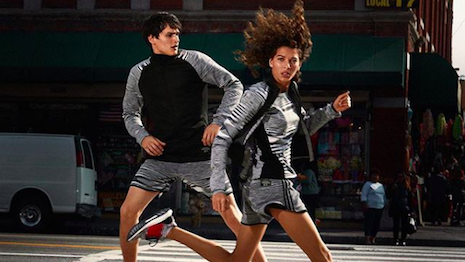- About
- Subscribe Now
- New York,
January 17, 2020

 Vestiaire Collective AW19 campaign. Image credit: Vestiaire Collective
Vestiaire Collective AW19 campaign. Image credit: Vestiaire Collective
NEW YORK – While China is fueling a significant portion of luxury growth, the millennial generation is poised to have a greater impact on the business’ expansion in the coming years.
During Luxury FirstLook 2020, a senior partner from Boston Consulting Group presented findings from the Global True Luxury Consumer Survey, which found that between 2018 and 2025, millennials will account for 130 percent of all luxury growth, whereas Chinese consumers will be responsible for 75 percent of the increase. The speaker noted that a number of the key trends that have put pressure on luxury players to change including casualization and customization are showing signs of stabilization, pointing to less dramatic shifts in the market for the near future.
"I would categorize this past year as more of an evolution than a revolution in true luxury," said Christine Barton, managing director and senior partner at Boston Consulting Group.
"I do think that will change as more of the Gen Z enter the markets," she said. "But I expect the next few years, outside of an exogenous event – either social, political or recessionary – to be more of the same as well next year."
Luxury FirstLook 2020 was produced by Luxury Daily, with venue sponsor UBS
True-luxury buyers
Between 2018 and 2025, the luxury market excluding categories such as automotive, yachts and jets, is projected to grow at a compound annual growth rate of 4.6 percent. Personal luxury goods growth during that time will be at 3 percent, while experiential purchases are expected to rise at a CAGR of 5.4 percent.
While experiential purchases have been climbing in recent years, Ms. Barton noted that growth in this category is now slowing, while there is going to be increased growth in personal luxury goods such as fashion. The researcher partly attributes this to pent-up demand after consumers pulled back on material goods purchases.
By 2025, millennials will represent half of all spending in the personal luxury goods category. Gen Zers will triple the amount they spend on luxury, but will still only represent about an 8 percent share of the total sales.
Gen Z is expected to more closely resemble the Gen Xers, with a focus on buying into quality and status that will be a boon to luxury brands. The rise of this generation will bring about more changes for how luxury should operate, but this wave will be hitting further into the future.
Aside from millennials, China is also seeing significant growth, and it will account for 40 percent of total personal luxury goods sales by 2025.
Chinese consumers will be 40 percent of the luxury market in 2025. Image credit: Fendi
Among luxury buyers, there is a cohort that BCG refers to as true-luxury consumers, or those who spend at least 5,000 euros per year on luxury. While these 18.5 million individuals are only 4 percent of the total population that buys luxury, they account for 30 percent of all luxury sales.
In some cases, a luxury brand may find that 0.1 percent of its customers are driving about 20 percent of its business. Compared to the aspirational individual who might buy a handbag once a year, the top true-luxury customers are likely to shop more frequently.
Ms. Barton noted the importance of customer acquisition in this segment, since 90 percent of all true-luxury growth between 2018 and 2025 will come from new clients.
Even though true-luxury consumers have the capacity to spend big on luxury goods, they still tend to mix and match between luxury labels and lower priced fashion.
This high-low aesthetic is reflected in true-luxury buyers’ interest in special editions or collaborations. Half of these shoppers say they have made a purchase from one of these limited time lines, with the trend driven predominantly by younger generations.
 Missoni's Adidas collaboration. Image credit: Missoni
Missoni's Adidas collaboration. Image credit: Missoni
These high-end shoppers are also embracing the secondhand luxury market, which is expected to grow 12 percent between 2018 and 2021.
Almost half of true-luxury buyers have participated in the secondhand market. While younger generations are more apt to have bought or sold luxury via resale, about four in 10 baby boomers and silver generations shoppers say they have participated.
Gens X, Y and Z are more skewed towards having sold merchandise, whereas older generations are more inclined towards buying pre-owned goods than selling.
According to previous research from BCG, resale platforms are often one of the first ways that up-and-coming consumers access and purchase luxury goods, with 71 percent of pre-owned buyers gravitating towards items they cannot afford new. Additionally, secondhand luxury appeals to more environmentally-conscious consumers as it keeps quality items from being discarded (see story).
After the climb of casual wear in the luxury market in recent years, the shift away from formal fashion appears to be stabilizing.
As brands look to reach the true-luxury consumer, social media and influencers is the number one category that these customers identify as influential. These are followed by magazines and brand Web sites, pointing to the role storytelling plays in driving purchase decisions.
About half of luxury purchase journeys begin online. However, 40 percent of purchase paths still take place entirely in-store.
Sustainability shift
While other trends have been fairly flat this past year, sustainability is an exception. Today, 56 percent of true-luxury customers say they investigate a brand’s social responsibility, up 11 percentage points from 2013.
Responding to the importance consumers are placing on sustainability for purchase decisions, luxury brands are taking action.
A growing number of luxury firms are launching carbon-neutral initiatives in an effort to boost their green goals. On Sept. 24, Kering joined brands including Porsche and Gabriela Hearst that have established carbon offset programs and promises (see story).
One challenge within sustainability is the fact that it crosses over a number of categories, including environmental and social issues.
Ms. Barton noted that rather than making a shallow investment across a number of areas, it would be more impactful for a brand to go deep into a single area that resonates with the company and its customers.
There are also challenges relating to sustainable sourcing. As consumer demand for sustainable fashion accelerates, apparel companies are ambitiously planning to significantly ramp up their offerings and transparency in the coming years.
According to a McKinsey study of chief purchasing officers, most executives foresee having half of their products fashioned from sustainable materials by 2025. The industry has a long way to go to reach this scale of sustainable sourcing, and companies will have to surpass hurdles including growing costs and material availability to reach this goal (see story).
"From a luxury perspective, the biggest question that we probably get [in terms of sustainability] is around the scarcity of being able to source sustainable materials and then set up sustainable supply chains," Ms. Barton said.
"So you’ve got a situation where effectively manufacturing and fabric innovation has betted ahead of consumer adoption and more importantly consumer willingness to pay for sustainability," she said. "And so you don’t have the supply and the supply chain, and it’s hard to build it at fast as the consumer demand is building."
Share your thoughts. Click here